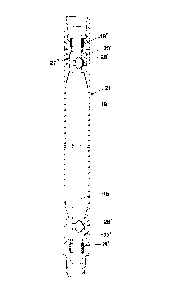Une partie des informations de ce site Web a été fournie par des sources externes. Le gouvernement du Canada n'assume aucune responsabilité concernant la précision, l'actualité ou la fiabilité des informations fournies par les sources externes. Les utilisateurs qui désirent employer cette information devraient consulter directement la source des informations. Le contenu fourni par les sources externes n'est pas assujetti aux exigences sur les langues officielles, la protection des renseignements personnels et l'accessibilité.
L'apparition de différences dans le texte et l'image des Revendications et de l'Abrégé dépend du moment auquel le document est publié. Les textes des Revendications et de l'Abrégé sont affichés :
| (12) Brevet: | (11) CA 1316168 |
|---|---|
| (21) Numéro de la demande: | 1316168 |
| (54) Titre français: | ELEMENT DE TRAIN DE SONDE |
| (54) Titre anglais: | DRILL STRING ELEMENT |
| Statut: | Périmé et au-delà du délai pour l’annulation |
| (51) Classification internationale des brevets (CIB): |
|
|---|---|
| (72) Inventeurs : |
|
| (73) Titulaires : |
|
| (71) Demandeurs : |
|
| (74) Agent: | GOWLING WLG (CANADA) LLP |
| (74) Co-agent: | |
| (45) Délivré: | 1993-04-13 |
| (22) Date de dépôt: | 1989-04-25 |
| Licence disponible: | S.O. |
| Cédé au domaine public: | S.O. |
| (25) Langue des documents déposés: | Anglais |
| Traité de coopération en matière de brevets (PCT): | Non |
|---|
| (30) Données de priorité de la demande: | ||||||
|---|---|---|---|---|---|---|
|
Abstract
The present invention relates to a drill string element
adapted to be coupled to other similar drill string elements
by thread connections (19) thus forming a drill string for top
hammer drilling. Each drill string element includes at least
one rod (15;15';15") for transferring impact energy to a drill
bit (11) provided at the lower end of the drill string (10)
and a tube assembly (21;21';21") for transferring rotation to
the drill bit (11), said tube assembly surrounding the rod.
When handling drill string elements of the above-mentioned
type it is extremely important that this handling can take
place in a safe way without any risk for accidents during
operation working site. Previously known drill string
elements of the type in question have the disadvantage that
the rod can fall out of the tube assembly in one direction.
Also the accessibility to the interior of the drill string
element in connection with repairs/service must be considered
and the drill string elements must stay intact during
operation, especially when they are unscrewed from each other.
The invention is characterized by that the tube assembly
(21;21';21") in the area of the two ends of the rod
(15;15';15") is provided with an internal diameter reducing
(27;27',27";27'''), and that the rod (15;15';15") is provided
with cooperating radial projections (28;28') or shoulder means
(28"). Also the tube assembly (21;21';21") includes at least
two tubular members (18;18';18") that are coupled to each
other by a thread connection that is harder to unscrew than
the thread connection (19) for coupling together the drill
string elements.
Note : Les revendications sont présentées dans la langue officielle dans laquelle elles ont été soumises.
Note : Les descriptions sont présentées dans la langue officielle dans laquelle elles ont été soumises.

2024-08-01 : Dans le cadre de la transition vers les Brevets de nouvelle génération (BNG), la base de données sur les brevets canadiens (BDBC) contient désormais un Historique d'événement plus détaillé, qui reproduit le Journal des événements de notre nouvelle solution interne.
Veuillez noter que les événements débutant par « Inactive : » se réfèrent à des événements qui ne sont plus utilisés dans notre nouvelle solution interne.
Pour une meilleure compréhension de l'état de la demande ou brevet qui figure sur cette page, la rubrique Mise en garde , et les descriptions de Brevet , Historique d'événement , Taxes périodiques et Historique des paiements devraient être consultées.
| Description | Date |
|---|---|
| Inactive : Demande ad hoc documentée | 1996-04-13 |
| Le délai pour l'annulation est expiré | 1995-10-15 |
| Lettre envoyée | 1995-04-13 |
| Accordé par délivrance | 1993-04-13 |
Il n'y a pas d'historique d'abandonnement
Les titulaires actuels et antérieures au dossier sont affichés en ordre alphabétique.
| Titulaires actuels au dossier |
|---|
| SANDVIK AB |
| Titulaires antérieures au dossier |
|---|
| KENNETH L. LARSSON |
| SVEN P. LILJEBRAND |